Deliverability
How technical and marketing teams can join forces to support email deliverability
Whose job is it to make sure your messages avoid the spam folder and achieve inbox placement? Find out how email marketers and technical experts can team up to ensure optimal deliverability while boosting email ROI.
PUBLISHED ON
When your emails keep landing in spam or get blocked by mailbox providers, it’s a major cause for concern. Email is a communication channel with an incredible return on investment (ROI). However, that’s only true when your messages make it to as many inboxes as possible.
It’s unfortunate, but when things go wrong in many companies, there’s a lot of blaming and finger-pointing. Email deliverability issues are no exception. So, who bears ultimate responsibility for inbox placement?
The truth is, there are a lot of technical aspects connected to reliable deliverability. But email marketing strategy also has an important role to play. Let’s explore who’s in charge of what and how marketers and technical teams can work together.
Table of content
Technical teams and email deliverability
Marketing teams and email deliverability
1. Sender reputation
2. Email validation
3. Blocklist monitoring
4. Measurement
Why email deliverability is crucial to business success
When Sinch Mailgun surveyed close to 2,000 senders for our report, “The state of email deliverability 2023”, we found that deliverability is directly connected to customer experience.
Among senders who make email deliverability a priority, 40% say the biggest benefit is Improved customer satisfaction. That’s likely because automated transactional emails are a cornerstone of customer communication for many businesses. If a user of your application fails to receive a password reset email, or a customer’s order confirmation email never shows up, it’s a problem. That’s going to cause some dissatisfaction.
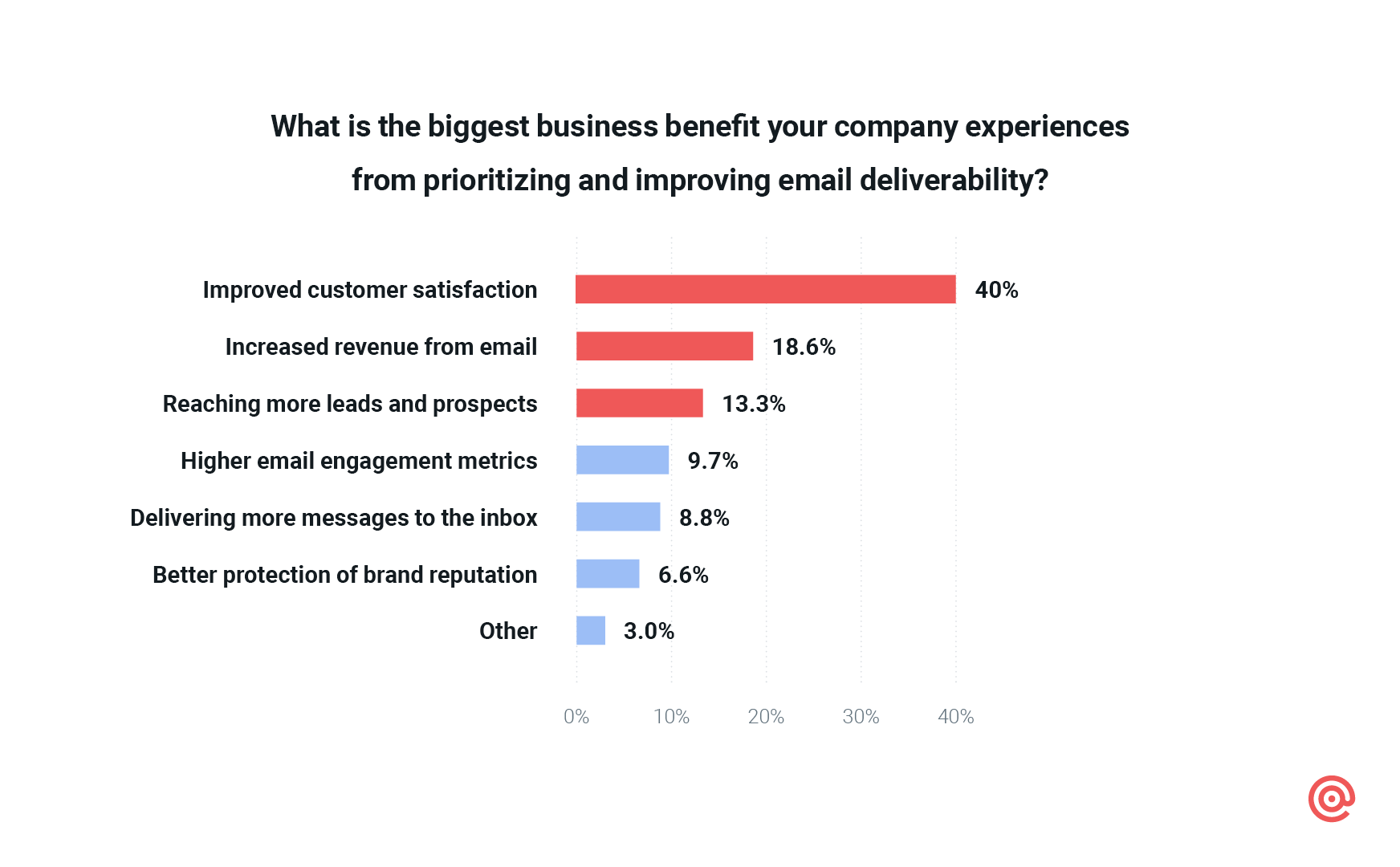
In our survey, the second biggest benefit of prioritizing deliverability was Increased revenue from email. This benefit is more closely connected to marketing emails. For example, an ecommerce company could make money every time it emails its list. But if those emails start landing in spam, revenue generation will decline.
The third biggest benefit was Reaching more leads and prospects. This demonstrates email’s value as a communication channel that nurtures leads and helps convert them into loyal customers. But you can’t use email to move prospects down the marketing funnel unless your nurture campaigns land in their inboxes.
The point is this... Email is a necessity for nearly every business, and inbox placement is vital if you want the channel to support your company’s growth. For that reason, everyone should care about email deliverability.
But who impacts those results?
Are you staying out of the spam folder?
The state of email deliverability 2023
Dive deeper into email deliverability with more from our exclusive report. Find out what hundreds of senders around the world are doing to reach the inbox and hear from experts who’ve spent their careers navigating this complex topic. Explore the insights now. No form filling required.
Email deliverability tasks and responsibilities
When mailbox providers start filtering your emails into junk folders, you’re bound to have a lot of questions. Was the marketing team doing something spammy? Was there some sort of technical issue with email sending infrastructure? Could there be a problem with a shared IP or your email service provider (ESP)?
Those are all good things to ask. But the reality of the situation may be that there are multiple issues damaging deliverability. What you really need is a strong understanding of email deliverability best practices among everyone involved.
Learn more: If you have no idea what questions you need to be asking around deliverability, get up to speed with our guide: Understanding the complexities of email deliverability.
There are two sides to the deliverability coin: technical tasks and email marketing tactics. It’s the combination of these areas that make up your organization’s email deliverability strategy.
Technical teams will work on projects such as choosing between cloud-based or on-premises email infrastructure. They’ll set up email authentication protocols and review DMARC reports for suspicious activity.
Marketing teams oversee many day-to-day activities that can impact inbox placement. That includes adding new subscribers to your list, keeping that list clean, and keeping those subscribers engaged with your emails.
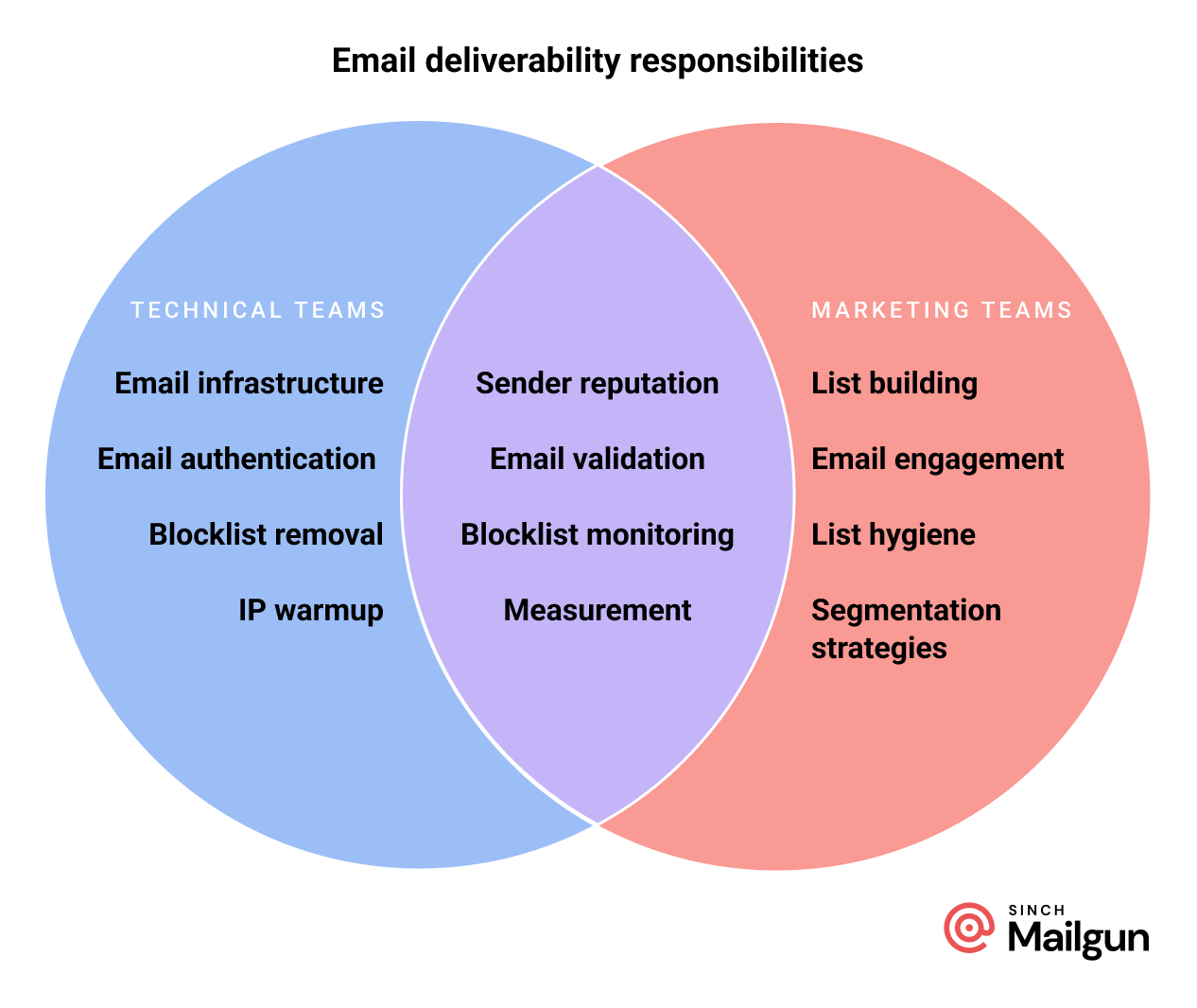
As the Venn diagram above shows, there are also shared email deliverability responsibilities that fall to both marketers and technical experts. That’s partly because just about everything related to deliverability is connected in some way.
Think of the flow of emails like a plumbing system. A blockage in one pipe could easily clog up everything else, which prevents your emails from flowing into the inbox. If you don’t want your email deliverability blocking the drain, it helps to understand how everything works.
Technical teams and email deliverability
Some of the responsibilities of technical team members (IT professionals, software developers, reliability engineers, etc.) are bigger projects that don’t require ongoing attention once complete. But these projects are also the foundation of an email program that is built with deliverability in mind. Why? Because these projects impact performance, speed, storage, and network capabilities.
Any time there are changes in that foundation, technical experts will get involved. Here are some examples of the biggest technical responsibilities:
1. Email infrastructure
Beyond choosing between on-premises and cloud-based email servers, there are other key infrastructure decisions that can impact deliverability.
One of those decisions is choosing whether it’s necessary to have separate mail streams for different types of emails. The most common way to do this is to use subdomains or different sending IPs for transactional emails and marketing emails.
Our survey found that, while just over 42% of all senders use this tactic to support inbox placement, it’s even more prominent among high-volume senders from enterprise organizations. Results show more than 60% of respondents with send volumes above 100,000 emails a month separate transactional and commercial email sending.
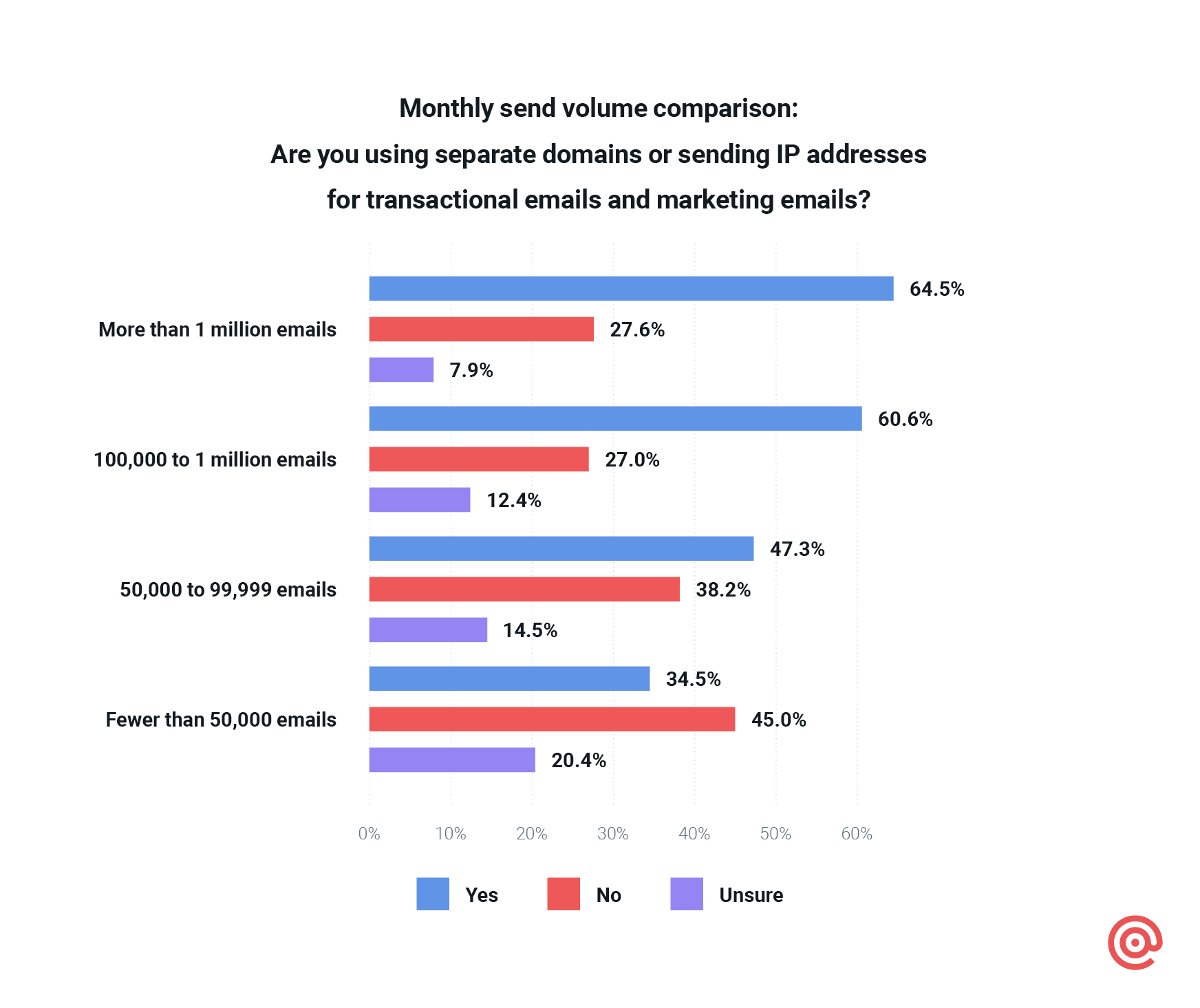
So, what’s the point of doing this?
Transactional emails often contain important information that users expect to receive almost immediately. Thanks to those expectations, transactional messages also have relatively high open rates. Marketing emails, however, tend to get less engagement as well as higher unsubscribe and spam complaint rates. As a result, mailbox providers may be more likely to filter promotions into spam.
When transactional and promotional emails come from the same domain or IP, it increases the chances for transactional emails to suffer the same fate. And you really don’t want transactional messages landing in junk. Whether separate mail streams make sense for your program or not, this is a clear example of how email marketing activities can impact overall deliverability.
2. Email authentication
Email authentication protocols help mailbox providers make the inbox a safer place for their users. That’s because these DNS text records are used to prove you are who you claim to be as a sender. This is done by authenticating your sending domain and IP addresses that have the authority to send on your behalf.
These protocols include Sender Policy Framework (SPF), DomainKeys Identified Mail (DKIM), and Domain-based Message Authentication, Reporting and Conformance (DMARC). They help stop phishing attacks such as email brand spoofing. It’s typically the responsibility of technical team members to set up and test these specifications.
Email authentication is somewhat complicated, but it’s still important for marketing teams to have a basic understanding of how it works and why it’s important. Our survey found a lot of uncertainty around whether these protocols were being used.
More than 30% of senders we surveyed were unsure if they were using SPF or DKIM and close to 40% didn’t know if they were using DMARC for authentication. Those numbers increased when we looked at non-technical roles only.
Learn more: At Sinch Mailgun, it’s required that senders set up protocols like SPF and DKIM before they use our platform. We also strongly recommend using DMARC, which checks for SPF and DKIM alignment while suggesting how to filter emails that fail authentication.
DMARC reports provide an overview of email traffic sent on behalf of your domain. Mailgun’s Nick Schafer explains how these reports may also alert technical teams when others in the organization are trying out new software for sending email. He saw it firsthand in our own company.
“When we first set up DMARC policies, it was really interesting to get those reports and see all the traffic. We started noticing all these places using Mailgun.com as the sending domain. A lot of it actually was our traffic, but we just didn�’t know about it. For example, our marketing team could try out a new service, and the protocols aren’t aligned. But, at least with DMARC reports, we can see what’s happening.”
Nick Schafer, Sr. Manager of Deliverability and Compliance, Sinch Mailgun
3. Blocklist removal
Getting blocklisted can seem scary, especially if a major provider like Spamhaus is blocking your messages.
If your organization is lucky enough to have employees who are dedicated to email deliverability, they will be the ones who handle troubleshooting the blocklisting. That includes communicating with the blocklist or mailbox provider. Either way, getting to the bottom of the situation could require some technical know-how. And the sooner you get delisted, the less of a negative impact there will be.
Our survey found most senders who’d been recently blocklisted were able to get removed in a matter of days. However, a significant portion (14.3%) said the situation was still unresolved.
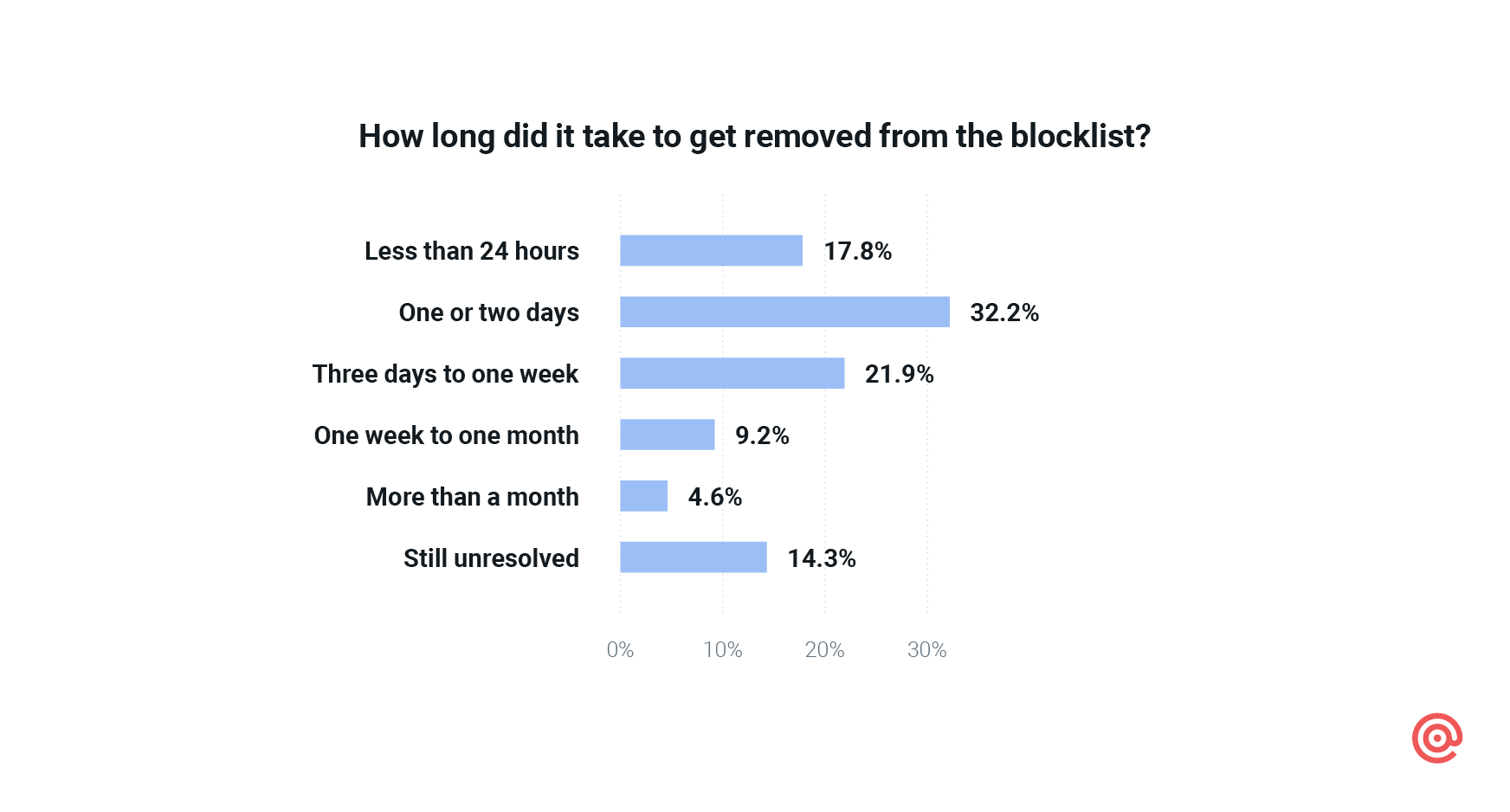
While some blocklist providers offer an explanation for rejecting your emails, there will also be times when you need to investigate. Understanding bounce classifications and error messages from a mailbox provider like Microsoft Outlook can help you fix problems or even prevent a blocklisting before it happens. But that requires some email deliverability expertise.
About 30% of blocklisted senders said they sought outside assistance and advice when they needed to get delisted. That’s something the deliverability team at Sinch Mailgun can help with.
“With Microsoft, for example, our team can often map out events that led up to the block by investigating failures and warnings that point back to the problem. That’s the benefit of having folks on your side who understand deliverability.”
Ashley Rodriguez, Deliverability Engineer, Sinch Mailgun
4. IP warmups
Sending domains and IP addresses have a history or reputation, which mailbox providers use to evaluate the quality of incoming mail and how to filter it. But when you start fresh, a new domain or sending IP hasn’t built a reputation yet. So, what happens then? You've got to start slowly.
Close to 28% of senders in our survey who’d been recently blocklisted said they chose to switch from a shared IP to a dedicated IP as a result. When that happens, it’s a bad idea to immediately send a high volume and high frequency of mail from the new IP.
Mailbox providers will think that a sudden large sending volume from an IP with no history seems spammy and suspicious. It could result in throttling, greylisting, filtering to junk, or even getting the IP blocked.
Technical teams can instead use an IP warmup service to gradually increase send volumes and slowly but consistently build up a positive reputation for the new dedicated IP. An IP warmup can also be a manual process. However, that requires a ton of tedious work.
Marketing teams and email deliverability
Email marketers have a lot on their minds, and deliverability may not always be their top priority. They care more about opens, clicks, the latest promotions, and the eye-catching email designs they’re sending out.
But wait... all of that can affect inbox placement too. Here’s how some key marketing efforts can help or hurt email deliverability.
1. List building
A popular email marketing mantra is “The money is in the list.” When you grow your email list, you’re bound to grow revenue. But let’s imagine your email list is a garden. If you end up with a bunch of weeds in there, revenue growth could get choked out.
Those “weeds” are better known as spam traps, which are fake or very old/unused email addresses that mailbox providers use to identify spammers. Spam traps usually end up on your list when marketers conduct shady list-building practices. That includes purchasing a list of contacts and scraping the web to collect email addresses.
Spam traps end up on purchased lists and are hidden on pages around the web. If you send to a spam trap, you’re definitely a spammer. It’s a sure sign you’re sending unsolicited emails to people who never subscribed.
Our research found that 12.5% of survey respondents had purchased email contacts and 9.9% used software to harvest email addresses. That doesn’t sound like much. But we were surveying legitimate senders – not spammers. These list building practices are just plain wrong, and marketers should avoid them at all costs. Make sure you only email contacts who’ve opted in, especially if you want to stay compliant with privacy laws like GDPR and the CCPA.
An even better way to build your list is to implement a double opt-in process. This requires new subscribers to click a confirmation link in an initial email before they’re officially added to your list. Unfortunately, we found that more than half of senders still aren’t using a double opt-in.
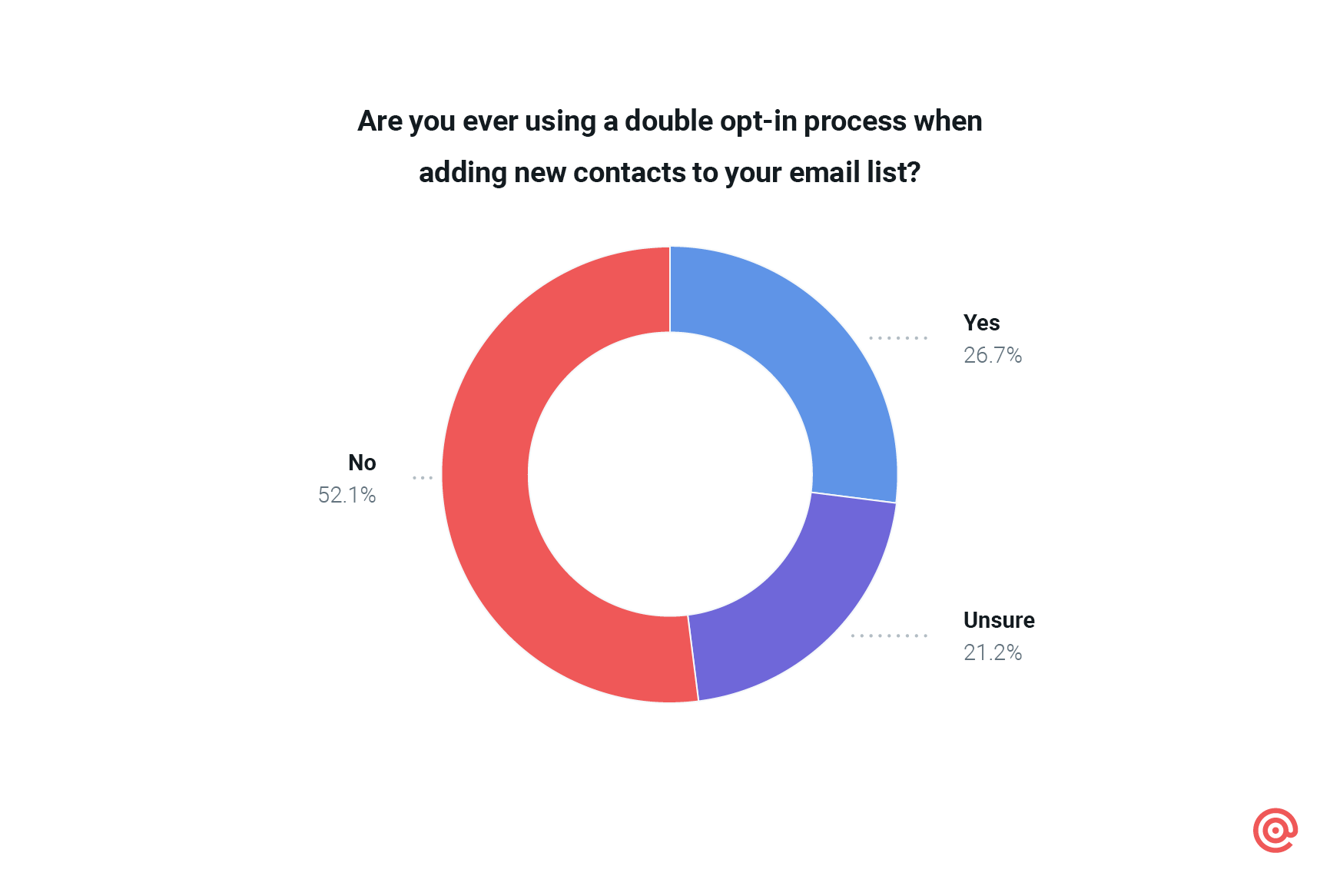
In our report, deliverability expert Nick Schafer said he thinks every sender should be using a double opt-in, especially if they care about building a healthy list that supports high levels of inbox placement.
2. Email engagement
Marketers can check out email analytics to understand campaign performance. Do you know who else has access to all those email marketing metrics? Mailbox providers.
Gmail, Apple Mail, Outlook, Yahoo! Mail – these services know exactly how often your subscribers are opening messages and clicking links. They also know how often your emails get deleted and marked as spam.
Email engagement (or the lack of it) is a major factor in scoring your sender reputation. This means the quality of campaigns and content as well as the actions of email recipients matter quite a bit. Things like intriguing subject lines and creative calls to action have an indirect impact on inbox placement. The same can be said of boring, ineffective subject lines and poorly designed email campaigns. But obviously, one approach is better for engagement than the other.
Monitoring metrics like open rates and click rates also informs senders about overall list health and deliverability. When we asked senders which deliverability metrics they actively measure, opens and clicks were in the top three.
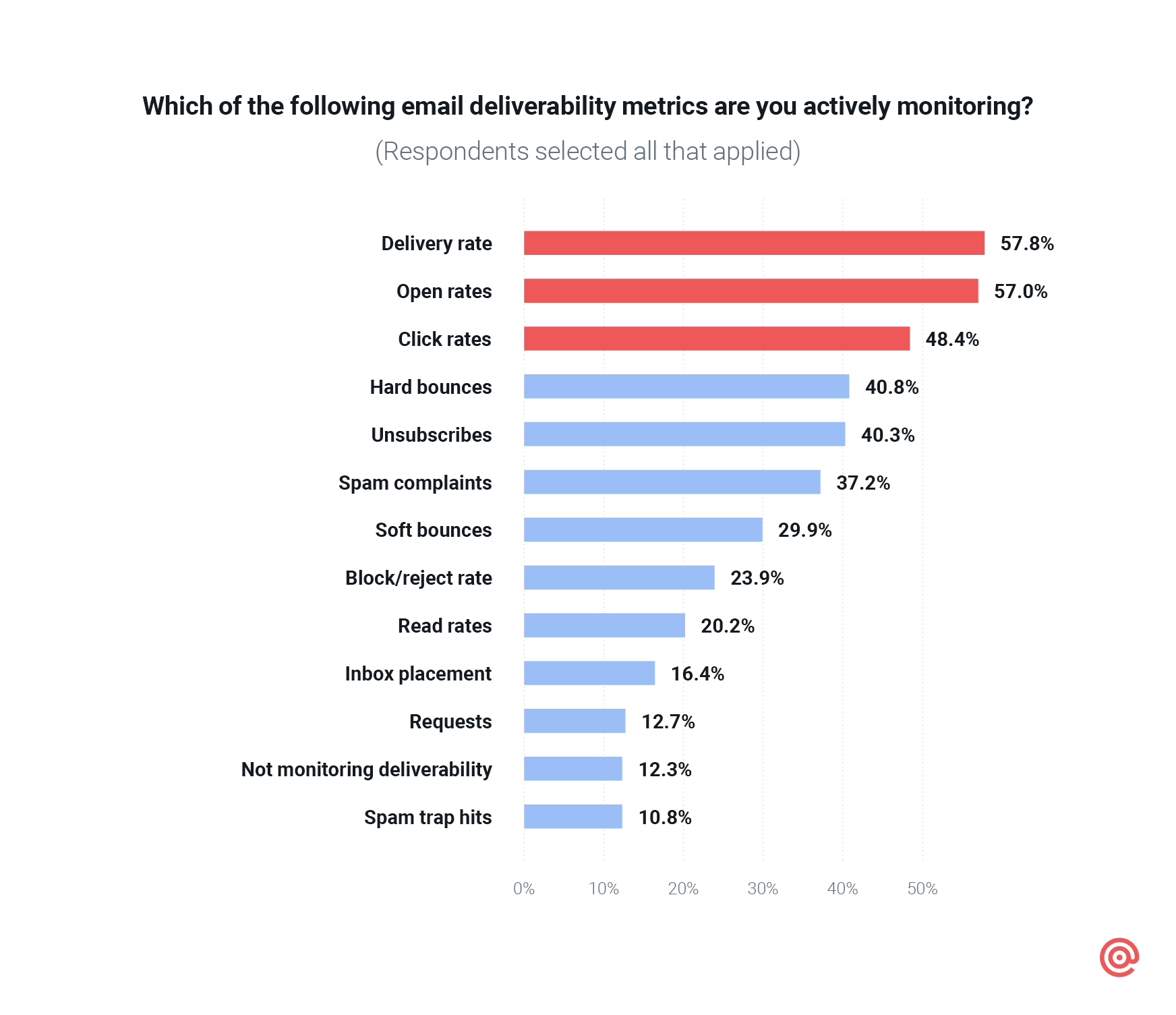
When you’re getting lots of opens and clicks, it’s a positive signal to mailbox providers. You’ll be more likely to land in the inbox if these providers know their users want what you’re sending.
Deliverability experts at Sinch Mailgun also say your unique open rate shouldn’t fluctuate much, and a decline in opens could be a warning sign that more messages are landing in spam.
“If you start noticing a trend of open rates dropping, it is usually a good indicator that you are facing email deliverability issues.”
Alexandre Zibrick, Compliance and Deliverability Engineer, Sinch Mailgun
3. List hygiene
Another important task that’s related to email deliverability and usually lands on the marketing team’s plate is managing the health and quality of the email list. That includes conducting list hygiene to remove outdated contacts and invalid email addresses as well as subscribers who’ve stopped opening and clicking.
The reason is simple: Removing invalid, outdated, and unengaged contacts boosts your overall engagement rates, which in turn supports sender reputation and deliverability. List hygiene is another way to pull the “weeds” out of the hypothetical garden that is your contact database.
In “The state of email deliverability 2023”, we found there’s a big disparity among senders concerning list hygiene schedules. A general rule of thumb is to clean up your email list at least twice a year. While our survey shows that 27.4% of senders conduct list hygiene monthly, a combined 38.7% say they rarely or never do.

4. Segmentation strategies
Smart email marketers will segment an email list so they can deliver more targeted, relevant campaigns to recipients. That’s good for deliverability because subscribers are more likely to engage with emails that reflect their needs, interests, and lifestyles.
You need data to segment and personalize emails. However, there’s also a way to segment new subscribers to support list health and deliverability with nothing more than an email address.
Confirmed Opt-in Lite (COIL) is a list-building strategy that is a little less strict than the double opt-in process. With COIL, you segment new subscribers on a separate list until you know if they’re actually going to engage with the emails you send.
This is part of what’s known as strategic engagement, which involves minimizing the impact of non-engaged recipients by segmenting them into a different list. You can then email those contacts less frequently and send more emails to subscribers who are highly engaged.
A sunset policy is often part of a strategic engagement plan. This involves setting benchmarks, so you know when to move a contact from one list to another. Like the double opt-in, our survey found well over half of senders have not implemented a sunset policy.
Check out the video below to learn more about strategic engagement:
How to team up for better deliverability
We’ve covered a lot of the factors that impact inbox placement, but some of the most important are found at the intersection of that Venn diagram from earlier. These are the things that often involve both technical teams and email marketers.
Think of these areas as opportunities to start collaborating if you want to improve your email deliverability strategy:
1. Sender reputation
We’ve already mentioned the importance of email engagement when it comes to establishing a good sender reputation. But that’s only one of many elements that mailbox providers use to score your reputation as an email sender. There are also important technical factors, including:
IP reputation
Domain reputation
Sending history
List hygiene
Email authentication
Your IP reputation and domain reputation are significant factors in scoring sender reputation. Some mailbox providers, such as Gmail, are likely placing a higher importance on domain reputation. That’s because your domain is tied more closely to your brand and industry. And while you can share an IP address or switch sending IPs, you’re usually stuck with your domain. This is an example of how brand reputation (a marketing initiative) could impact sender reputation (a technical issue).
Proper email authentication is another way to show you are a trustworthy, legitimate sender whose messages should go straight to the inbox. That’s why our Inbox Placement Testing feature lets you know if you are passing or failing SPF, DKIM, and DMARC authentication.
Brand Indicators for Message Identification (BIMI) is a newer email specification that’s connected to DMARC. It enables senders to have a verified logo displayed in the inbox if they meet the right requirements. A BIMI logo boosts brand awareness, builds trust, and can increase engagement. It’s the perfect example of how marketing efforts and technical email specifications intersect.
Our survey found that 8% of senders have gotten BIMI set up so far while another 8.8% say they’re working on it. BIMI implementation is another example of a project in which technical teams and marketers need to work together. One team sets up and tests the specification while the other decides on inbox branding and designs logo files.
2. Email validation
One way to be proactive about list hygiene is to verify that new contact data is valid before it gets added to your list. There’s no efficient way to do this manually. No one is standing over the shoulders of new subscribers making sure they don’t accidentally type “gnail.com” or use a disposable email address.
Since technical teams often influence technology purchase decisions, they can help marketers out by suggesting helpful tools like an email validator. If you integrate email validation into the marketing team’s online sign-up forms, you’ll be verifying addresses in real-time.
Survey results show that close to 25% of senders are validating emails at the point of signup. However, more than 50% are not using any tools for email address verification.
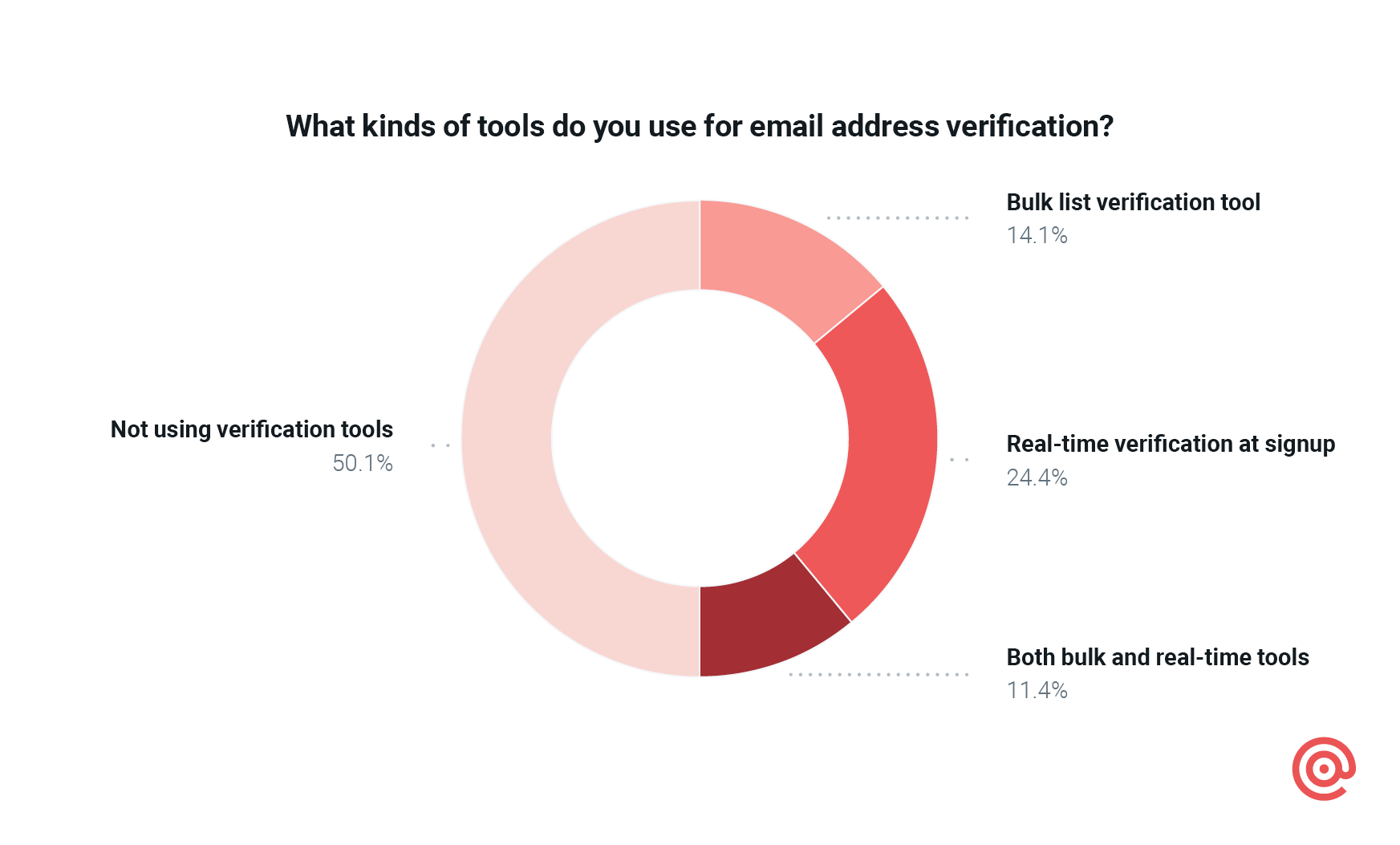
3. Blocklist monitoring
Since email marketers are looking at analytics regularly, they may be able to catch changes in metrics that indicate deliverability problems such as a blocklisting. Of course, the marketing team has to know what to look for first.
An unexpected decrease in engagement is one sign, and another is an increased bounce rate. Sometimes bounces may indicate invalid email addresses, but they can also mean that mail servers are rejecting your emails. But why? Are you actually on a blocklist, or is there another reason for the rejections?
Reputation Monitoring services like ours provide technical teams and marketers with a place to monitor blocklists so any issues can be addressed ASAP. You’ll receive a notification if your domain or IP address gets added to any of the many blocklists we are monitoring. Plus, you’ll get bounce classifications that help you understand what could be affecting deliverability.
Both marketing and technical teams can keep an eye on these deliverability metrics to make sure emails keep flowing and problems are resolved before it impacts communication and revenue generation.
4. Measurement
Technical teams and marketers tend to have their eyes on different data points. While the marketing team analyzes performance metrics, technical experts check email logs to diagnose potential delivery issues.
Of course, delivery and deliverability are measured differently. Your delivery rate is only the beginning of finding out whether an email lands in the inbox. This is one of the biggest misconceptions about email deliverability. Let’s have a quick refresher...
The delivery rate is a measure of how many emails are accepted by receiving mail servers divided by the total number of messages sent:
Delivery rate % = (# of messages delivered ÷ # of messages sent) X 100
While the delivery rate excludes emails that bounce, it includes emails that are filtered to spam. Those messages were technically delivered too. A much better way to understand deliverability is to measure the inbox placement rate, which is the number of emails that make it to the inbox divided by the number of messages delivered.
Inbox placement rate % = (# of messages in the inbox ÷ # of messages delivered) X 100
The inbox placement rate can only be evaluated with seed testing – a process of sending test emails to seed mailboxes from a variety of providers to find out where they’re most likely to land.
The senders we surveyed told us that avoiding the spam folder is their biggest deliverability challenge. The only way to have any idea whether your emails will be filtered into spam is to conduct inbox placement testing. However, only 16.4% of the senders we surveyed said they monitored the inbox placement rate.
To get much better visibility into email deliverability, technical teams and email marketers can conduct Inbox Placement Testing and review reports from Sinch Mailgun. This helps you get big-picture deliverability insights and lets you drill down to see results for specific, major mailbox providers.
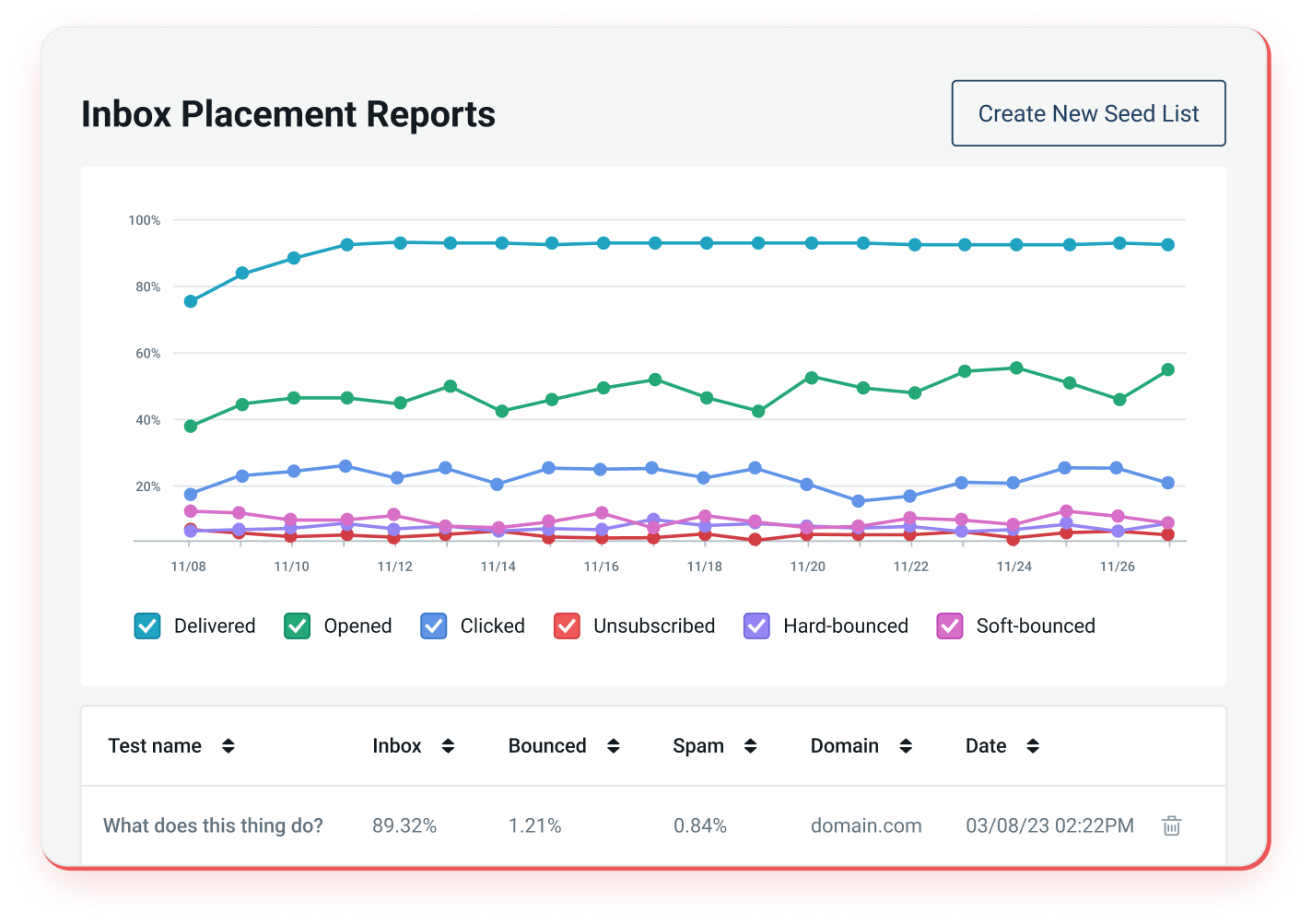
Communicate and share knowledge
Given all the different tasks and factors that affect email deliverability, it’s easy to see how marketing and technical teams can get siloed. You do your job. I’ll do mine. Stay out of my way.
Okay, maybe it’s not that harsh. But the best way for technical teams and marketers to work together in support of email deliverability is to open communication and share insights with each other.
Our survey results showed there’s quite a bit of uncertainty around certain topics. In some cases, marketers may have no clue about authentication and infrastructure. Technical teams may gain insights into sender reputation from knowing more about the organization’s email marketing strategy.
“Meeting in the middle and bringing technical teams and email marketers together is what helps you be successful because you’re able to have your marketing team meet their goals while making sure it’s done in a proper manner that supports deliverability.”
Ashley Rodriguez, Deliverability Engineer, Sinch Mailgun
Whether it’s a shared dashboard of deliverability metrics, a lunch-and-learn to offer education on best practices, or regular meetings to share insights and concerns – find ways to connect technical teams and marketing teams. Email deliverability takes teamwork, and it is too important to ignore.
Get strategic help from deliverability experts
Only around 4% of respondents who participated in our survey described themselves as “deliverability specialists.” Most organizations don’t have these sorts of experts on staff. And the ones who do are using advanced software and partnering with other industry experts.
Sinch Mailgun built a suite of deliverability tools that provide you with everything you need to increase inbox placement and get the most out of the email channel. Discover why Forrester found that, for an example composite organization over the first three years, Mailgun can deliver an ROI of 264%.
Want to build a scalable, high ROI email program with a focus on inbox placement? Consider working with Sinch Mailgun’s Deliverability Services. We’ll help you create a strategy that’s customized to your organization's needs.






